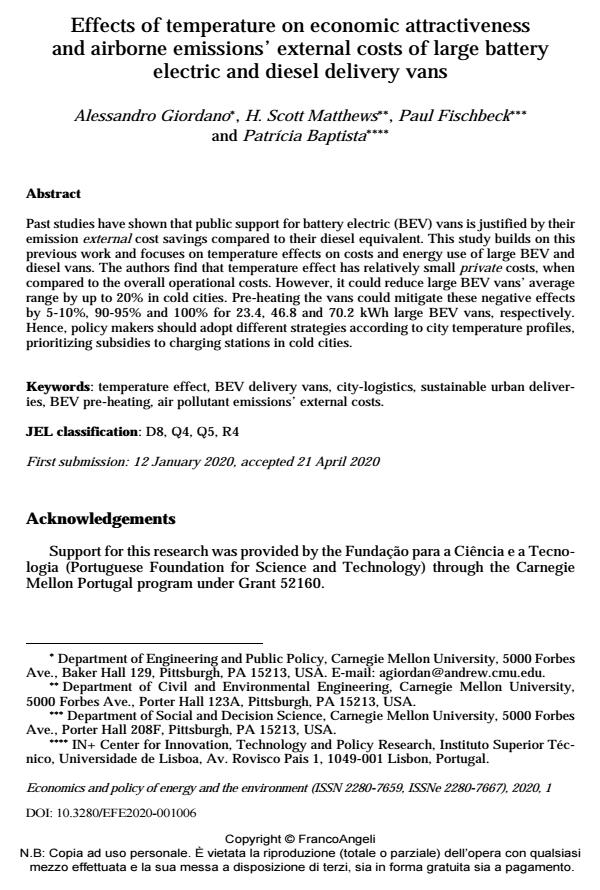Effects of temperature on economic attractiveness and airborne emissions’ external costs of large battery electric and diesel delivery vans
Titolo Rivista ECONOMICS AND POLICY OF ENERGY AND THE ENVIRONMENT
Autori/Curatori Alessandro Giordano, H. Scott Matthews, Paul Fischbeck, Patrícia Baptista
Anno di pubblicazione 2020 Fascicolo 2020/1 Lingua Inglese
Numero pagine 57 P. 95-151 Dimensione file 701 KB
DOI 10.3280/EFE2020-001006
Il DOI è il codice a barre della proprietà intellettuale: per saperne di più
clicca qui
Qui sotto puoi vedere in anteprima la prima pagina di questo articolo.
Se questo articolo ti interessa, lo puoi acquistare (e scaricare in formato pdf) seguendo le facili indicazioni per acquistare il download credit. Acquista Download Credits per scaricare questo Articolo in formato PDF

FrancoAngeli è membro della Publishers International Linking Association, Inc (PILA)associazione indipendente e non profit per facilitare (attraverso i servizi tecnologici implementati da CrossRef.org) l’accesso degli studiosi ai contenuti digitali nelle pubblicazioni professionali e scientifiche
Past studies have shown that public support for battery electric (BEV) vans is justified by their emission external cost savings compared to their diesel equivalent. This study builds on this previous work and focuses on temperature effects on costs and energy use of large BEV and diesel vans. The authors find that temperature effect has relatively small private costs, when compared to the overall operational costs. However, it could reduce large BEV vans’ average range by up to 20% in cold cities. Pre-heating the vans could mitigate these negative effects by 5-10%, 90-95% and 100% for 23.4, 46.8 and 70.2 kWh large BEV vans, respectively. Hence, policy makers should adopt different strategies according to city temperature profiles, prioritiz-ing subsidies to charging stations in cold cities.
Keywords:Temperature effect, BEV delivery vans, city-logistics, sustainable urban deliveries, BEV pre-heating, air pollutant emissions’ external costs.
Jel codes:D8, Q4, Q5, R4
- Bazinski S.J., Wang X. (2015). Experimental study on the influence of temperature and state-ofcharge on the thermophysical properties of an LFP pouch cell. Journal of Power Sources, 293: 283-291.
- CE Delft et al. (2019). Sustainable Transport Infrastructure Charging and Internalisation of Transport Externalities, s.l.: European Commission, Directorate-General for Mobility and Transport.
- CE Delft et al. (2019). Sustainable Transport Infrastructure Charging and Internalisation of Transport Externalities, s.l.: European Commission, Directorate-General for Mobility and Transport.
- CE Delft, Infras, Fraunhofer ISI (2011). External Costs of Transport in Europe _ Update Study for 2008, s.l.: CE Delft.
- Circlek (n.d.). Historiske priser Truckdiesel. -- https://m.circlek.no/cs/Satellite?c=Page&childpagename=NO1%2FLayout&cid=1334077141669&p=1334077141669&packedargs=lang%3Dno_NO%26site%3DNO1&pagename=NO1Wrapper [Accessed 10.2019].
- Entso-e (2019). Statistical factsheet 2018, Brussels: European Network of Transmission System Operators for Electricity (entso-e).
- European Commission, (n.d.). Index of /emos_prod/reports/publicmaps/maps_weekly _oil_bulletin; September 2018 to September 2019. -- http://ec.europa.eu/energy/maps/maps_weekly_oil_bulletin/ [Accessed 10 2019].
- Eurostat (2019). Electricity prices for household consumers – bi-annual data (from 2007 onwards) [nrg_pc_204], s.l.: s.n.
- Fiamm (2012). FIAMM SONICK Battery Handbook for Vehicle Applications, s.l.: Fiamm.
- Finanzen.net (n.d.). CO2 European emission allowances – historical prices. -- https://www.finanzen.net/rohstoffe/co2-emissionsrechte/historisch [Accessed 11.2019].
- Giordano A., Fischbeck P., Matthews H.S. (2018). Environmental and economic comparison of diesel and battery electric delivery vans to inform city logistics fleet replacement strategies. Transp. Res. Part D, 64: 216-229.
- Manzoni R., Metzger M., Crugnola G. (2008). ZEBRA Electric Energy Storage System: from R&D to Market. Milan: HTE hi.tech.expo.
- Pesaran A., Vlahinos A., Stuart T. (2003). Cooling and Preheating of Batteries in Hybrid Electric Vehicles. NREL, s.n.
- Ricardo-AEA (2014). Update of the Handbook on External Costs of Transport, s.l.: Report for the European Commission: DG MOVE.
- SimaPro 8 (n.d.). Ecoinvent database 3.0. s.l., s.n.
- UCLA-Luskin Center for innovation (2012). Financial viability of non-residential electric vehicle charging stations, s.l.: UCLA Anderson.
- Yuksel T., Tamayao M.-A.M., Hendrickson C., Azevedo I.M.L., Michalek J.J. (2016). Effect of regional grid mix, driving patterns and climate on the comparative carbon footprint of electric and gasoline vehicles. Environ. Res. Lett., 11(4): 044007. DOI: 10.1088/1748-9326/11/4/044007
- Impacts of topography and weather barriers on commercial cargo bicycle energy using urban delivery crowdsourced cycling data Alessandro Giordano, H. Scott Matthews, Patrícia Baptista, Paul Fischbeck, in Sustainable Cities and Society 103326/2022 pp.103326
DOI: 10.1016/j.scs.2021.103326
Alessandro Giordano, H. Scott Matthews, Paul Fischbeck, Patrícia Baptista, Effects of temperature on economic attractiveness and airborne emissions’ external costs of large battery electric and diesel delivery vans in "ECONOMICS AND POLICY OF ENERGY AND THE ENVIRONMENT" 1/2020, pp 95-151, DOI: 10.3280/EFE2020-001006